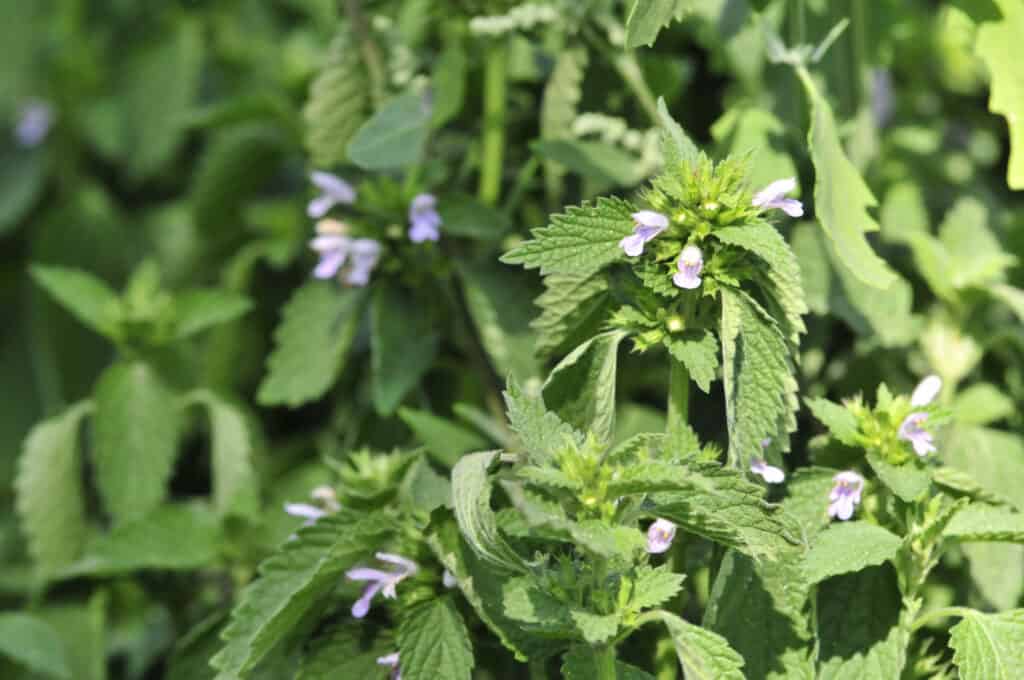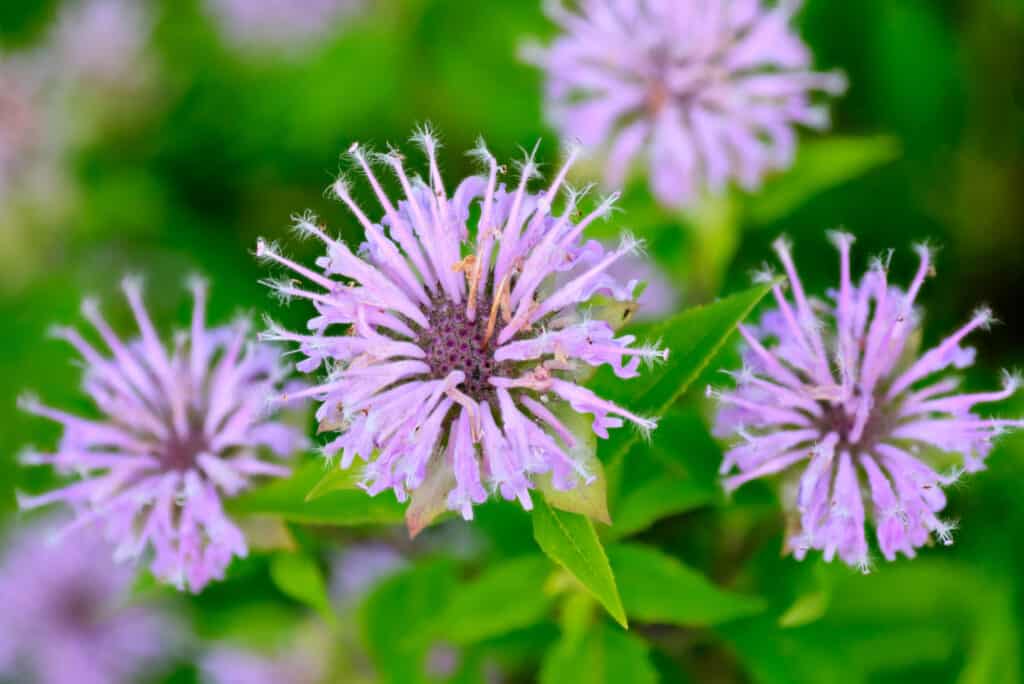Lemon balm and bee balm are herbs that give our foods delicious bursts of flavor. Though they are both used in cooking, lemon balm and bee balm are distinctively different in size, color, and shape, with very individual and exciting tastes.
Lemon balm is a perennial, meaning it will come back year after year, while bee balm is an annual plant that will only last for one growing season. Lemon balm also has a slightly sweeter flavor than bee balm, making it a good choice for desserts. On the other hand, Bee balm has a slightly spicier flavor, similar to oregano, making it a good addition to savory dishes.
Read on to discover more about the differences between lemon balm and bee balm, their origins, uses, and how to grow these delicious flowering herbs, so you can decide which you want in your garden!
Difference Between Lemon Balm and Bee Balm
| Lemon Balm | Bee Balm | |
|---|---|---|
| Classification | Kingdom: Plantae Clade: Tracheophytes Clade: Angiosperms Clade: Eudicots Clade: Asterids Order: Lamiales Family: Lamiaceae Genus: Melissa Species: M. officinalis | Kingdom: Plantae Clade: Tracheophytes Clade: Angiosperms Clade: Eudicots Clade: Asterids Order: Lamiales Family: Lamiaceae Subfamily: Nepetoideae Tribe: Mentheae Genus: Monardo |
| Common Names | Cure-all, honey plant, Melissa, sweet balm, and sweet Mary, balm mint, common balm | Bergamot, Oswega tea, horsemint |
| Origin | Native to the Mediterranean Basin, south-central Europe, Central Asia, and Iran | North America |
| Description | Grows 1-2 feet with 1/4 inch white flowers. Light green oval leaves with a citrus scent. | Grows 2-4 feet high with 2-3 inch showy flowers of differing shades red/pink, purple or white with bright green spear-shaped leaves, great for adding flavor to food and tea. Believed to treat dental infections, improve insomnia, and treat cuts, burns, or rashes. Attracts pollinators. |
| How to Grow | – Plant in full sunlight in early spring – Soil pH should be 6.7-7.3 – Use well-draining, sandy loam – Water soil regularly | – Plant in full sunlight in spring or early fall – Use well-draining soil with neutral pH – Plant 20-24 inches apart – Keep soil moist – Deadhead faded blooms |
Lemon Balm vs. Bee Balm: Classification and Origin
Lemon balm is a herbaceous perennial plant that is also known as balm mint or common balm. This delicious, sweetly scented herb of the genus Melissa, is native to the Mediterranean Basin, South-Central Europe, Central Asia, and Iran. However, these days lemon balm is grown just about everywhere. Lemon balm and bee balm are both from the Lamiaceae (mint) family but belong to different genera.
The ancient Romans and the ancient Greeks used lemon balm, while herbalists and writers have chronicled the use of the herb dating back to the middle ages.
Bee balm, genus Monardo, is endemic to North America and prized for its showy flowers. Other names include horsemint, bergamot, bee balm, wild bergamot, and oswego tea. Like lemon balm, bee balm is a herbaceous perennial plant, though some varieties are annuals. Bee balm produces flowers with purple, pink, or white blossoms.
Bee balm was discovered by the Oswego tribe, who used the flowers to make tea. The genus was after the botanist Nicolas Monarda, who wrote a book on North American plants.
Lemon Balm vs. Bee Balm: Description
Lemon balm can grow one to two feet tall with 1/4-inch white flowers that are full of nectar in the summer. When slightly rubbed, the soft, light green leaves release an intense lemon scent, making identifying lemon balm incredibly easy.

When rubbed, lemon balm’s leaves release a sweet, lemony scent.
©iStock.com/petrovaliliya
Bee balm grows to two to four feet with slender, tubular flowers that come in various colors, such as lavender, purple, white, red, and pink. The flower heads are around two to three inches wide, blooming from June through July. Bees and hummingbirds are the primary pollinators of bee balm. Their long tongues make it easy to reach the nectar in the flowers. Bee balm leaves smell of mint when crushed.

Bee Balm’s tubular flowers come in various colors, such as lavender, purple, white, and red.
©damann/Shutterstock.com
Lemon Balm vs. Bee Balm: Uses
Lemon balm and bee balm have a variety of uses in the home – whether for ornamental purposes or consumption.
The distinctive citrus scent of Lemon balm’s leaves acts as a natural insect repellent, making it a good choice for growing around other garden plants to repel insects that might otherwise inflict damage. Thanks to its lemony scent, lemon balm often gets used in essential oil blends. Gardeners add a few drops of lemon balm oil to water, misting themselves and their plants to repel gnats and other insects!
Lemon balm is an herb that adds flavor to water, tea, candy, and even fish cuisine. The leaves can be dried for adding to casseroles, salads, or soups for a fresh taste!
Nicholas Culpeper, an English botanist, believed that lemon balm could help people feel “merry,” open brain obstructions, and help with digestion. For thousands of years, it has been thought that lemon balm can treat the following conditions:
- anxiety
- cold sores
- insomnia
- menstrual pain
- digestive problems
Bee balm has long been cultivated to attract birds, bees, and butterflies, which it does tanks to its stately blossoms. Beautiful when in full bloom, this herb symbolizes good luck, health cleanliness, and purity.
Believed health benefits of bee balm include:
- Remedy for cuts or rashes
- Remedy for skin burns
- Freshens breath and treats dental infections
- Bee Balm tea is believed to help with depression
- Treat fever, chills, and nausea
- relieves insomnia
Please note: A-Z Animals does not recommend plants or herbs for medicinal or health use. We present the following information for academic and historical purposes only.
Lemon Balm vs. Bee Balm: How to Grow
How to Grow Lemon Balm
Lemon balm is a self-seeding, herbaceous perennial plant that grows best in full sunlight. It can be aggressive, so monitor its growth because it will spread as far and wide as allowed. Lemon balm grows best in well-draining, sandy loam with a neutral to acidic pH. Though lemon does produce flowers in the summer, the blooms are quite small, growing among the foliage, making them difficult to spot.
Growing Lemon Balm Tips
- Plant lemon balm in early spring.
- Space the plants 18-24 inches apart and ¼ inch deep.
- The ideal pH is 6.7-7.3.
- Evenly water the soil regularly.
- Remove unwanted plants to prevent self-sowing.
- Hardy in Zones 4-9
How to Grow Bee Balm
Bee balm is a perennial herb that does best in full sun but will tolerate partial shade, though it will not flower as well. Keep it moist, but not too wet, throughout the growing season. Provided with their optimum environment, they will grow to 2 feet!
Growing bee balm tips
- Plant bee balm in the spring or early fall.
- Space the plants 20-24 inches apart from one another.
- Keep soil pH neutral.
- Keep the soil evenly moist and water every seven days.
- Deadhead faded blooms when necessary.
- Grows in Zones 3-9
So, which herb is right for you? Both herbs look great in the garden and will add delicious and distinct flavors to food and drinks.
The photo featured at the top of this post is © Cavan-Images/Shutterstock.com
Sources
- Wikipedia, Available here: https://en.wikipedia.org/wiki/Lemon_balm
- Wikipedia, Available here: https://en.wikipedia.org/wiki/Monarda
- Wikipedia, Available here: https://en.wikipedia.org/wiki/Nicol%C3%A1s_Monardes
- WebMD, Available here: https://www.webmd.com/diet/health-benefits-lemon-balm#1
- Natural Health News, Available here: https://www.natural-health-news.com/bee-balm/
FAQs (Frequently Asked Questions)
Is lemon balm and bee balm the same thing?
Lemon balm and bee balm are both herbs that belong to the same family. However, they are herb species that belong to a different genus. Lemon balm has a citrus flavor, while bee balm has a mint scent and flavor.
Do bees like lemon balm?
Honeybees and butterflies love lemon balm. In addition, the citrus scent of lemon balm will repel mosquitos and gnats.
Does bee balm come back every year?
Yes! Bee balm is a perennial plant that will return each year and spread quickly.
Thank you for reading! Have some feedback for us? Contact the AZ Animals editorial team.







